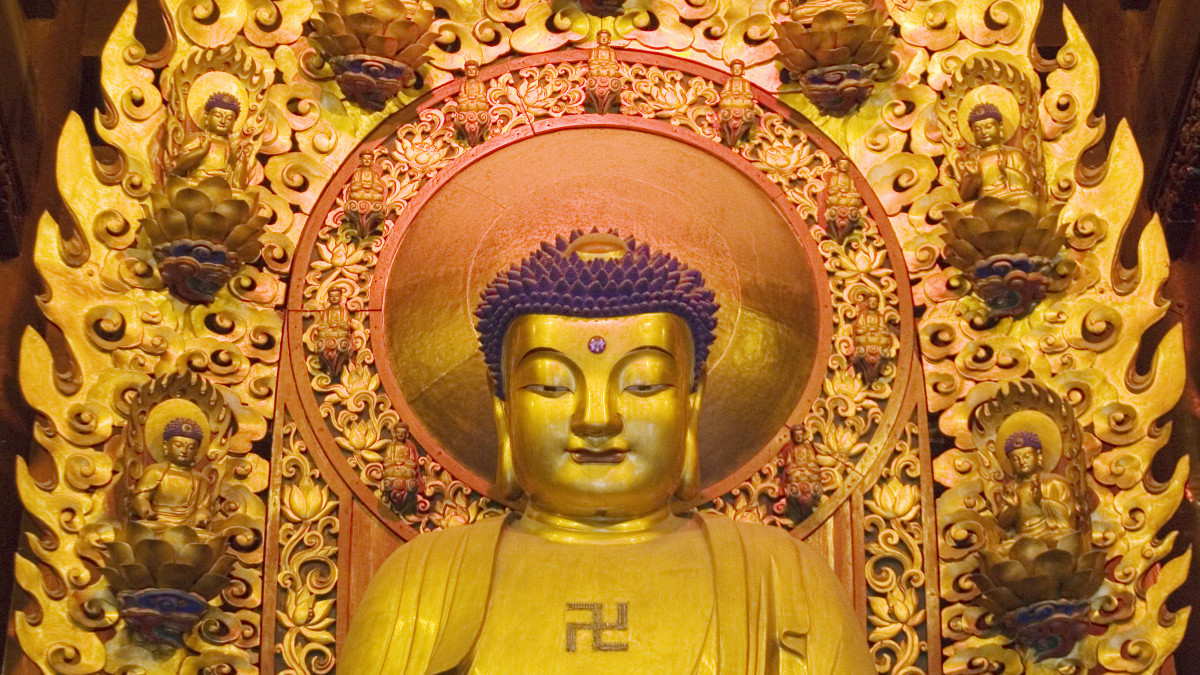
Buddhism is the world’s fourth most popular religion, with over 507 million followers worldwide. Traveling around India, China and other traditionally Buddhist countries reveals ornate temples, Buddha shrines and devout followers (much like many of the world’s other great religions!).
However, Buddhism is also frequently referred to as a philosophy, particularly by people in the West. It shares many teachings in common with other popular schools of thought, such as Stoicism. And Buddha himself emphasized the practical nature of his ideas, favoring philosophical enquiry over religious dogma.
All this begs the question: is Buddhism a philosophy or a religion? This article explores why and how Buddhism means different things to different people, and whether or not it can ever be truly classified as one thing or the other.
Is Buddhism a Religion or a Philosophy? Or Both?

Buddhism first originated in India in the 6th century BC. It is a non-theistic religion i.e. it doesn’t believe in a creator God, unlike theistic religions such as Christianity. Buddhism was founded by Siddhartha Gautama (also known as Buddha) who, according to legend, was once a Hindu prince. However, Siddhartha eventually decided to give up his wealth and became a sage instead.
Get the latest articles delivered to your inbox
Sign up to our Free Weekly Newsletter
He came to this decision after gaining an awareness of human suffering and the pain it causes people. Consequently Siddhartha led an ascetic lifestyle. He devoted himself to developing a belief system which
could teach others how to escape samsara, a Sanskrit word which describes the “suffering-laden cycle of life, death, and rebirth, without beginning or end” (Wilson 2010).
Despite its popularity today, Buddhism was slow to gain followers at first. During the 6th and 5th century BC, India was undergoing a period of significant religious reform. Buddhism developed in response to the supposed failure of Hinduism to adequately address the needs of everyday people. But it was only in the 3rd century BC that the religion gained traction. Indian Emperor Ashoka the Great adopted Buddhism and consequently it spread rapidly through the Indian subcontinent and Southeast Asia.
Some Key Teachings

As stated above, Buddha began to develop his teachings after realizing the true scale of suffering in the world. In particular, he realized that because of human mortality, everything he loved would eventually die (including himself). But death isn’t the only suffering in human life. Buddha believed that humans suffer at birth (both the mother and the baby), and throughout life due to desire, envy, fear etc. He also believed that everyone was reincarnated in the samsara and doomed to repeat this process forever.
Therefore Buddhist teaching aims to break this cycle. The “Four Noble Truths’ illustrate Buddha’s approach in more detail:
- Life is suffering
- The cause of suffering is craving
- The end of suffering comes with an end to craving
- There is a path which leads one away from craving and suffering
These truths provide the basis for the entire purpose of Buddhism, which is to find the path away from craving and suffering through enlightenment.
The ‘Philosophical’ Aspects of Buddhism

Already we can see some philosophical aspects of Buddhism beginning to emerge. The Four Noble Truths above sound remarkably similar to typical logical reasoning involving premises and relations between premises.
But perhaps the most concrete philosophical elements to this religion come from Buddha himself. Rather than imploring his followers to follow his teachings to the letter, Buddha encourages people to investigate them. Buddhist teachings, otherwise known as Dharma (Sanskrit: ‘truth about reality’), contain six distinct characteristics, one of which is Ehipassiko. This word is used all the time by Buddha and literally means “come and see for yourselves”!
He strongly encouraged people to engage in critical thinking and draw on their own personal experience to test what he was saying. This type of attitude is extremely different to religions such as Christianity and Islam, where followers are generally encouraged to read, absorb and accept scripture unquestioningly.
It’s also important to note that Buddha’s teachings have spurned a distinct philosophical tradition. As people began to write down his lessons in the centuries after his death, differing interpretations rose up among diverse philosophical groups. At first, the people debating Buddhist teachings employed standard philosophical tools and techniques to make their point. However, their reasoning was underpinned by a total belief that whatever Buddha said was right and true. Eventually, people from distinct but related Asian religions began to analyze Buddhist teachings, forcing Buddhists to branch out into traditional areas of philosophy (e.g. metaphysics, epistemology) to prove the value and worth of Buddhism to other people who didn’t consider Buddha’s teachings as authoritative.
The ‘Religious’ Aspects of Buddhism

Of course, there are plenty of religious aspects to this religion also! We’ve already seen that Buddha believes in reincarnation, for example. He describes how when someone dies, they are reborn again as something else. What an individual is reborn as depends on their actions and how they behaved in their previous life (karma). If Buddhists want to be reborn into the realm of humans, which Buddha believes is the best one to achieve enlightenment, then they must earn good karma and follow Buddha’s teachings. So even though Buddha encourages critical enquiry, he also provides an excellent incentive to follow what he is saying.
Many world religions also offer some sort of ultimate reward for its followers to try and aim for throughout their lives. For Christians, this is reaching Heaven after death. For Buddhists, this is a state of enlightenment known as nirvana. However, nirvana is not a place but rather a liberated state of mind. Nirvana means that someone has realized the ultimate truth about life. If an individual achieves this state then they have escaped the cycle of suffering and rebirth forever, because in their enlightened mind all the causes of this cycle have been eliminated.

There are also many Buddhist rituals and ceremonies that form an important part of worship for many people around the world. Puja is a ceremony in which followers will typically make offerings to Buddha. They do so in order to express their gratitude for Buddha’s teachings. During puja followers may also meditate, pray, chant and repeat mantras.
This devotional practice is performed so that followers can open themselves up more deeply to the teachings of Buddha and nurture their religious devotion. Unlike some religions, in which ceremonies must take place under instruction from a religious leader, Buddhists can pray and meditate either in temples or their own homes.
Why Do We Need to Classify Buddhism as a Religion or Philosophy?

As we can see, Buddhism contains many characteristics which blur the lines between philosophy and religion. But the idea that we need to distinctly classify it as one thing or the other tends to arise within Western societies far more than in other parts of the world.
In the West, philosophy and religion are two very distinct terms. Many philosophies (and philosophers) within the Western tradition would not have considered themselves to be devoutly religious individuals. Or if they did, contemporary followers have managed to successfully extricate the philosophical from the religious aspects of a particular school of thought.
Many people who consider themselves atheists or agnostics tend to favor ignoring the religious aspects of Buddhism, for obvious reasons. After all, Buddhist teaching fits easily within the mindfulness, meditation and yoga movements which have gained in popularity in Western countries over the last few decades. Sometimes these teachings are appropriated without a proper understanding of their roots, as when people post Buddha quotes on social media or claim to be interested in Buddhism without having studied any of its key texts.
The truth is that Buddhism is both religion and philosophy, and the two aspects of its teachings can co exist in relative peace. People interested in Buddhist philosophy can easily study it as a school of thought, as long as they don’t try to deny that there are more supernatural elements contained within Buddha’s teachings. Buddhist monks, temples and religious festivals exist for a reason. Ceremony and ritual is an extremely important aspect of Buddhism to millions of people around the world. But equally, it is possible for an atheist to follow plenty of Buddha’s teachings without also feeling obliged to carry out acts of worship.
Bibliography
Jeff Wilson. Samsara and Rebirth in Buddhism (Oxford: Oxford University Press, 2010).








